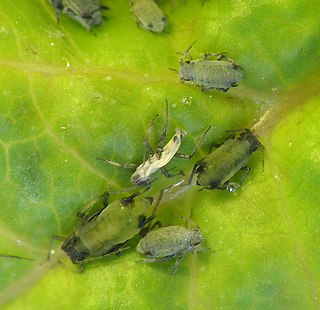Hyadaphis coriandri, the coriander aphid, is a species of aphid in the family Aphididae.

Hyadaphis is a genus of aphids in the family Aphididae. There are about 19 described species in Hyadaphis.

Grylloprociphilus is a genus of woolly and gall-making aphids in the family Aphididae. There is at least one described species in Grylloprociphilus, G. imbricator.

Longistigma caryae, the giant bark aphid, is a species of giant aphid in the family Aphididae.

Longistigma is a genus of giant aphids in the family Aphididae. There are at least three described species in Longistigma.

Macrosiphoniella millefolii is a species of aphid in the family Aphididae.

Macrosiphum albifrons, the lupin aphid, is a species of large grey/ green aphid in the family Aphididae.

Periphyllus is a genus of maple aphids in the family Aphididae. There are more than 40 described species in Periphyllus.

Phyllaphis is a genus of aphids in the family Aphididae. There are at least four described species in Phyllaphis.

Tetraneura ulmi, the elm sack gall aphid and also known as a fig gall, is a species of aphid in the family Aphididae. It was described by Carl Linnaeus and named in his Systema Naturae, published in 1758. The mite is found in Asia, Europe and North America, causing abnormal plant growths, known as galls on their primary host, elm trees (Ulmus species). They feed on a secondary host, the roots of various grasses.

Tetraneura is a genus of woolly and gall-making aphids in the family Aphididae. There are more than thirty described species in Tetraneura.

Uroleucon cirsii, the large thistle aphid, is a species of aphid in the family Aphididae.

Uroleucon nigrotuberculatum, the red goldenrod aphid, is a species of aphid in the family Aphididae.
Cerataphis is a genus of witch hazel and palm aphids in the family Aphididae. There are about 10 described species in Cerataphis.
Hayhurstia is a genus of aphids in the family Aphididae. There is one described species in Hayhurstia, H. atriplicis.
Sarucallis is a genus of aphids in the family Aphididae. There is one described species in Sarucallis, S. kahawaluokalani.

Capitophorus is a genus of aphids in the family Aphididae. There are more than 30 described species in Capitophorus.
Neophyllaphis is a genus of aphids in the family Aphididae. There are about 18 described species in Neophyllaphis.

Tamalia is a genus of aphids in the family Aphididae. There are eight described species in Tamalia.

Hormaphis is a genus of witch hazel and palm aphids in the family Aphididae. There are at least three described species in Hormaphis, found mainly in eastern North America.


















